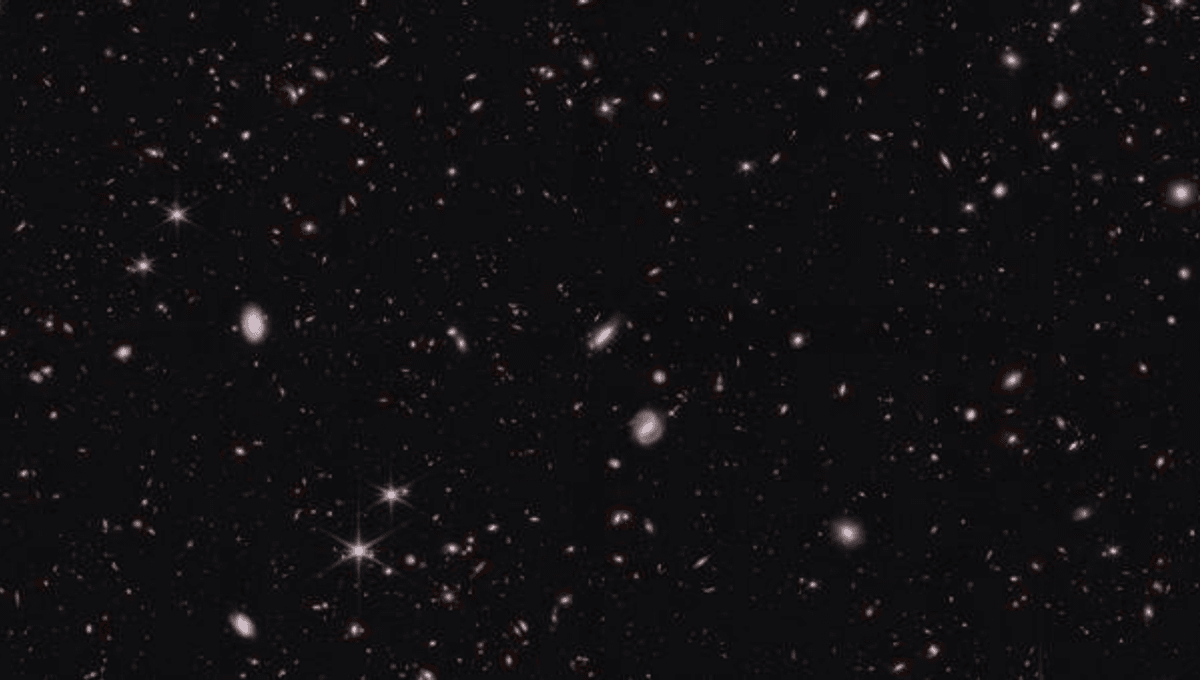
The apparent crisis in our models of the universe – caused by impossibly large galaxies soon after the Big Bang – may be no crisis at all, according to a new study. The authors conclude the galaxies in question are not as large as has been estimated. If this work is correct, the JWST has revealed an early universe not quite as we expected it, but not so badly different as to throw physics into crisis.
The JWST has dazzled us with gorgeous images and greatly advanced our knowledge of planets orbiting nearby stars. So far, however, its biggest impact on science has probably been the repeated discovery of unexpectedly evolved galaxies seen in the first few hundred million years after the Big Bang. These have gone from a few surprising anomalies to a major puzzle, with some people referring to a crisis in cosmology to go with the one created by conflicting estimates of the universe’s rate of expansion.
Before we decide our models of how galaxies form – or how old the universe is – are fundamentally broken, however, we should check if these galaxies are really that big. After all, even the JWST sees them as barely more than dots. A large team led by University of Texas at Austin graduate student Katherine Chworowsky says the galaxies don’t contain enough stars to be a problem.
The issue, Chworowsky and co-authors conclude, is that black holes are adding to the brightness of these early galaxies, and astronomers have mistaken this light for extra stars. “We are still seeing more galaxies than predicted, although none of them are so massive that they ‘break’ the universe,” Chworowsky said in a statement.
Black holes form accretion disks around them, where friction between fast-moving particles causes gasses to glow. This phenomenon is well known and very heavily studied – both for nearby black holes like M87* and the quasars that serve as major markers of the universe. Nevertheless, Chworowsky and co-authors claim it has not been sufficiently taken into account.
They’re not just creating an ad-hoc fix for the problem. Instead, the authors point to evidence of abundant fast-moving hydrogen in these early galaxies – exactly what is produced as gas spirals into a supermassive black hole.
The team estimated the contribution these accretion disks are making to the light we see. When they subtracted this from the observations, they found galaxy sizes half those others estimated at one distance, and a third even further. These are at the upper end of expectations, but not completely out of step with what astronomers anticipated.
These calculations have many potential sources of error. For example, we have to rely on estimates of a galaxy’s redshift to know its distance, and therefore how soon after the Big Bang we are seeing it. However, the team used two methods to make these estimates and found they agreed closely in most cases. Other aspects that could throw a spanner in the works are harder to resolve, such as assumptions about the dark matter halos around these galaxies – a particularly tricky topic given how little we understand about dark matter behavior.
Nevertheless, the findings at least raise the possibility that the problem that has been worrying cosmologists isn’t real.
“So, the bottom line is there is no crisis in terms of the standard model of cosmology,” said co-author Professor Steve Finkelstein. “Any time you have a theory that has stood the test of time for so long, you have to have overwhelming evidence to really throw it out. And that’s simply not the case.”
Still, it would be a boring old universe if everything could be explained perfectly, and even after this adjustment, the team acknowledges the JWST has spotted about twice as many massive galaxies as can be easily explained.
That doesn’t mean they are entirely at a loss as to why this might be. “Maybe in the early universe, galaxies were better at turning gas into stars,” Chworowsky said.
If some phenomenon of the era caused more rapid condensation of gas until fusion began, relative to modern scenarios, the problem would go away entirely. We’d still need to explain what that was, but some ideas have already been raised, noting how much denser the universe was before it had the time to expand to its current size.
The study is published in the Astrophysical Journal
Source Link: JWST’s Anomalously Large Early Galaxies May Just Be Acting Big